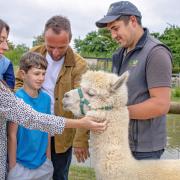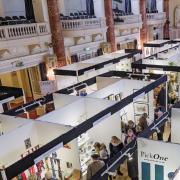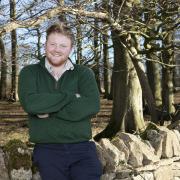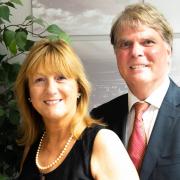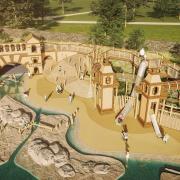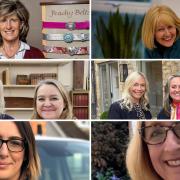Satellite technology can help solve big world challenges, says Stuart Martin, chief executive of the UK’s Satellite Applications Catapult, based at Harwell, near Didcot

Stuart Martin, CEO of the UK’s Satellite Applications Catapult, based at Harwell, sees the bigger picture.
Not because he’s got his sights set on space, though that’s clearly the biggest picture of all, they’re fixed on earth because he knows that’s where space and satellite technology can make a fundamental difference to humanity.
2015 heralded British’s first man in space and we watched agog as Tim Peake mended solar panels on the international space station. But as a nation we were decades late to the space race.
According to Stuart, it was precisely because we didn’t fund show-stopping projects such as the Apollo programme that Britain is now a world-leader (in some instances the world leader) in satellite technology. “Our space scientists had to find cleverer ways to secure funding, which meant achieving notable commercial successes,” explains Stuart.
Surrey Satellite Technology Ltd (SSTL) is a good example. One of the UK’s largest university spin-out businesses, it’s the world’s leading commercial small satellite company with an innovative approach to space engineering. In the 1980s, while others were thinking Star Wars, British scientists (probably harbouring resentful thoughts about skinflint government policies), started thinking outside the box. One was Professor Sir Martin Sweeting, who led a group of skilled aerospace researchers making small satellites using off-the-shelf components. No one else was doing that. Sweeting’s approach was simple: Design and launch small satellites to see what worked, and sell what did.Universities and even nation states wanting their own space capability bought them. Small satellites can be made more cheaply and launched into orbit faster; so new technology can be tested quicker for commercialisation and profit. SSTL is now an independent British company, a multi-million pound business employing hundreds of people within the Airbus Defence and Space Group.
There are other areas where the UK leads the world in satellite technology, including scientific instrumentation and space telecommunications satellites, GPS anti jamming and resilience.
Since 2013, the UK’s Satellite Applications Catapult has concentrated on transforming the way the world uses satellite technology. “Space satellites have the capacity to locate, connect and observe on a truly global scale, like no other technology,” says Stuart. “Satellite technology really can help some of the developing world’s biggest problems, such as environmental management and feeding a growing global population.”
This is a grandiose claim. Scientists, however (and he was a rocket scientist, how cool is that?), seldom make glib statements.
In September 2015, the United Nations updated its Millennium Goals by publishing 17 UN Global Goals for Sustainable Development to transform the world, setting the time frame for achievement as 2030, the same one as the Satellite Applications Catapult had written into its business plan. So Stuart looked how their ambitions aligned. “Many UN goals focus on ending poverty and hunger, and sustainably managing the world’s natural resources, precisely what we seek to support.”
Of course satellites aren’t new. What is new is the disruptive technology going on to develop the technology and find new commercial uses for it. One such is Uber, the mobile app connecting customers with taxi drivers in minutes. Uber faces massive resistance from established private taxi companies probably because it disrupts established practices, but for consumers, it’s clearly a winner.
One particularly exciting project developed by the Catapult in conjunction with the Pew Charitable Trusts, is Project Eyes on the Seas, a new satellite application making a huge contribution to ocean conservation. It has won an award from the Blue Marine Foundation.
Stuart explains: “Project Eyes on the Seas offers all governments equal access to real-time comprehensive monitoring and analysis of all fishing vessels, including those that don’t openly share their positions, and helps supermarkets ensure they buy their fish from legal and sustainable sources.”
Agriculture is another leading user of space technology. Technology once the preserve of huge prairie farms is now becoming available to smaller farm operators, across the world.
And satellites can also reveal areas in the world where new cultivation is possible. “The big issue in Africa is sustainable management of agriculture,” says Stuart. “Areas are viable for a few years then farming moves to the next plot of land. But with satellite technology information, some could be cultivated again, despite their distinct climate challenges.”
It is predicted that the UK’s space satellite industry has the potential to be worth £40 billion by 2030, creating 100,000 new jobs.
As a result the Catapult is doing everything it can to reach out to the UK community. “We also organise a structured series of events on a variety of topics throughout the year,” says Stuart. “They are all open door. Anyone can come. We run ‘inventorthons’ and hackathons at weekends, open to anyone so people can test their ideas. All the facilities here at Harwell are available. People can rent our technology by the hour, day or month to experiment. We also have hot desks in a campus style environment. We run events with venture capitalists, legal advisers, bankers, IP advisers, whatever our community wants. We have a regular ‘Satuccinos’ where people stand up and say what their business does. Around 60 people attend each month and lots of collaborations start that way.
“It’s an interesting time to come into space and we are benefitting from the investments of many of our partners in Europe over the last 20 years, says Stuart.
“Life science companies, chemical companies and materials manufacturers are all trying to understand what benefits come from working in a zero gravity environment. If you are trying to grow crystal structures or experimenting on plant genetics, can zero gravity help or give you a better product? There is some evidence that natural genetic mutations happen more readily in space than on the ground, so some companies are experimenting to see if they can develop new, ultra-resilient and productive crop types more effectively, without the downsides of GM.
“We encourage open innovation and try to take everyone we work with to what we think is the leading edge of knowledge.”
Catapult is also working with UK cities such as Manchester and Milton Keynes, in conjunction with the Future Cities Catapult, helping plan sustainable population growth.
So what is the future? For some international projects, it’s tantalizing near, says Stuart. “OneWeb, backed by Motorola and Richard Branson, has ambitions to launch a constellation of 700 satellites to provide affordable high-speed internet access to anyone, anywhere in the world, for a few dollars a month.” The intention is backed by the United Nations.
Autonomous cars have come in for criticism, but the new Galileo system will have resilience and an anti-jam facility boosting confidence in self-drive cars. The opportunities are infinite, according to Stuart. The only thing that limits us is our own imagination and the confidence to embrace it.
The Romance of Space
Stuart graduated from Imperial College in 1989 and went to work at the European Space Operations Centre at Darmstadt in Germany, Europe’s version of Houston. He worked on the first generation of earth observation satellites in Europe.
After five years, he returned to the UK to work for Logica. “I didn’t know then that the UK did much work in the space industry. It was pretty much under the radar. I worked on weather satellites, and a safety system developed for Ariane rockets that tracked the rocket as it went up. If it went off course, we could blow it up before it could damage life on earth.”
At one state he was flying out to French Guiana for every launch.
Stuart also worked on military communication systems and the Galileo satellite navigation system. In 2006 he became Logica’s head of space worldwide, and became convinced that the future of space technology was making better use of it on the ground. “The problem with space, which is also its advantage, is that people get seduced by the romance of it.”
Stuart got involved in setting up the International Space Innovation Centre, the predecessor to the Catapult, creating a three-way collaboration between government, industry and academia to make the most of space technology. He wrote the proposal for the Catapult, and was then invited to run it.
“It’s all about the confidence to take on new technology. The pace of change is speeding up. In the United States, it took around 43 years for electricity to be adopted by a majority of the population. Television took 26 years, mobile phones just eight.”
The UK Catapult Programme
The UK’s Catapults were set up by the Government in 2010 by the then Secretary of State Vince Cable, following a report commissioned by Peter Mandelson, to transform the UK’s capability for innovation in key areas. The objective was to drive future UK economic growth by having a physical base equipped with state of the art facilities and expertise where collaborative research and development can bring innovative ideas to life. Partially funded by the government, they also attract business and university-funded research and development contracts.
As well as the satellite centre at Harwell, other UK Catapults focus on medicines technologies, compound semiconductors, cell therapy, digital, energy systems, future cities, precision medicine, high value manufacturing and transport systems.
Project Eyes on the Seas
These days we can’t go anywhere without being tracked via CCTV or whenever a credit card is used. There are many data collection touch points and it’s almost impossible to commit organised crime without leaving a trail. Some international criminals have hit the high seas, making millions out of illegal fishing, dredging ocean bottoms in a highly unsustainable way and using slave labour among other outrageous practices.
Some fishing vessels are staffed entirely by slave labour, where average life expectancy can be 2-3 years. Once they expire, they are tossed overboard and the captain simply goes to remote beaches and collects more. Slave vessels never enter port, they transfer their catch ship to ship, which then pass them off as a legal catch. Large ships are supposed to use AIS tracking, ship-to-ship communication and collision avoidance, and these signals can be picked up from space.
Stuart explains Project Eyes on the Seas: “AIS information is entered into a database system, mapping it against other information such as fishing licences, marine protection zones etc. We build up a picture of what these ships are doing. However, AIS transponders can be switched off and go dark, often because they have something to hide. Imaging satellites can see what they are doing: perhaps sailing towards a marine protected zone or offloading to another ship which still has its transponder on.
“Organised crime has gone on to the ocean because the risk is extremely low, almost no one currently gets prosecuted, and the rewards are high. Fish is in demand and easy to get into the supply chain. We aim to increase the risk, get ships blacklisted so they can’t offload their catch into the supply chain, and we can support prosecutions with the evidence.”
Since launching a year ago, there has been worldwide interest in the system’s capabilities, including from some of the world’s biggest name supermarket brands, all interested in the role that satellite data can play in ensuring that they all operate legally and sustainably.




